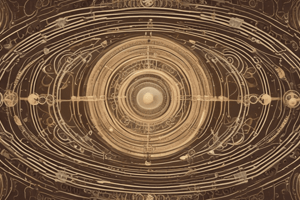Podcast
Questions and Answers
What were the four elements according to Aristotle?
What were the four elements according to Aristotle?
- Earth, Air, Fire, and Sky
- Earth, Water, Air, and Fire (correct)
- Fire, Earth, Air, and Water
- Wood, Fire, Earth, and Metal
What was the cosmological model of the Pythagoreans?
What was the cosmological model of the Pythagoreans?
- A combination of both geocentric and heliocentric
- Geocentric (correct)
- Indeterminate
- Heliocentric
How did the ancient Greeks prove the Earth is spherical without a telescope?
How did the ancient Greeks prove the Earth is spherical without a telescope?
- By observing the ships disappearing over the horizon
- By comparing the shadows of sticks in different cities
- By observing the different constellations at different latitudes
- All of the above (correct)
What was the theory of motion described by Aristotle?
What was the theory of motion described by Aristotle?
What was the significance of the Earth's shadow on the moon during an eclipse?
What was the significance of the Earth's shadow on the moon during an eclipse?
What was the significance of higher elevations and object visibility?
What was the significance of higher elevations and object visibility?
Which astronomer proposed a heliocentric model of the universe with the sun at the center and the planets orbiting around it?
Which astronomer proposed a heliocentric model of the universe with the sun at the center and the planets orbiting around it?
Which astronomer's theory solved the problem of 'retrograde motion' in planetary observations?
Which astronomer's theory solved the problem of 'retrograde motion' in planetary observations?
Whose observational data did Johannes Kepler use to develop the laws of planetary motion?
Whose observational data did Johannes Kepler use to develop the laws of planetary motion?
Which astronomer favored an Earth-centered universe and differed from Ptolemy's theory?
Which astronomer favored an Earth-centered universe and differed from Ptolemy's theory?
Which of Kepler's laws of planetary motion states that planets move faster in their orbits when they are closer to the sun?
Which of Kepler's laws of planetary motion states that planets move faster in their orbits when they are closer to the sun?
Who discovered the 'nova stella' and provided accurate astronomical data in the 17th century?
Who discovered the 'nova stella' and provided accurate astronomical data in the 17th century?
Flashcards are hidden until you start studying
Study Notes
Ancient Greek Physics and Astronomy
Pythagoreans (500 B.C.)
- Believed in a geocentric model, where the stars, planets, sun, and moon were attached to crystalline spheres that rotated around the Earth.
- Proposed three types of terrestrial motion: natural motion, forced motion, and rest.
Aristotle (350 B.C.)
- Proposed the concept of four elements: Fire, Earth, Air, and Water.
- Supported geocentrism, where the Earth is at the center of the universe.
- Showed that the Earth is spherical in shape.
- Developed the Theory of Motion, which included violent motion and natural motion.
- Described three types of motion: diurnal motion, annual motion, and precession of the equinoxes.
Evidence for a Round Earth
- Ship-and-horizon observation: as a ship disappears over the horizon, the hull disappears first, indicating a curved Earth.
- Constellations from different latitudes: the angle of the constellation changes as one moves north or south, indicating a spherical Earth.
- Earth's shadow on the moon during an eclipse: the curved shape of the shadow indicates a spherical Earth.
- Higher elevation and visible distance: the higher the elevation, the farther one can see, indicating a curved Earth.
- Comparison of shadows cast in different cities (e.g., Aswan and Alexandria): the difference in shadow lengths indicates a spherical Earth.
Ancient Greek Astronomy
- Described observable astronomical phenomena using the Earth's motion as a basis:
- The Earth's tilted axis
- The Earth's rotation
- The Earth's revolution
- The motion of the Moon around the Earth
- The alignment of the Earth, Moon, and Sun in a straight line
Models of the Universe
Plato's Model
- Not specified in the text.
Eudoxus' Model
- Not specified in the text.
Aristotle's Model
- Not specified in the text.
Ptolemy's Model
- Not specified in the text.
Aristarchus and Copernicus
- Proposed a heliocentric model, where the Sun is at the center of the universe and the planets orbit the Sun.
- Copernicus' model solved the problem of "retrograde motion" but did not immediately replace Ptolemy's theory.
Tycho Brahe (1600)
- Favored an Earth-centered universe different from Ptolemy's theory.
- Made accurate astronomical observations, including the discovery of a "nova stella".
- Proved that comets are found in the Celestial Domain.
- Removed the necessity of crystalline celestial spheres.
Johannes Kepler (1609)
- Used Tycho's observational data to develop laws of planetary motion.
- Developed Kepler's 3 Laws of Planetary Motion:
- Law of Ellipses
- Law of Equal Areas
- Law of Periods
Studying That Suits You
Use AI to generate personalized quizzes and flashcards to suit your learning preferences.




